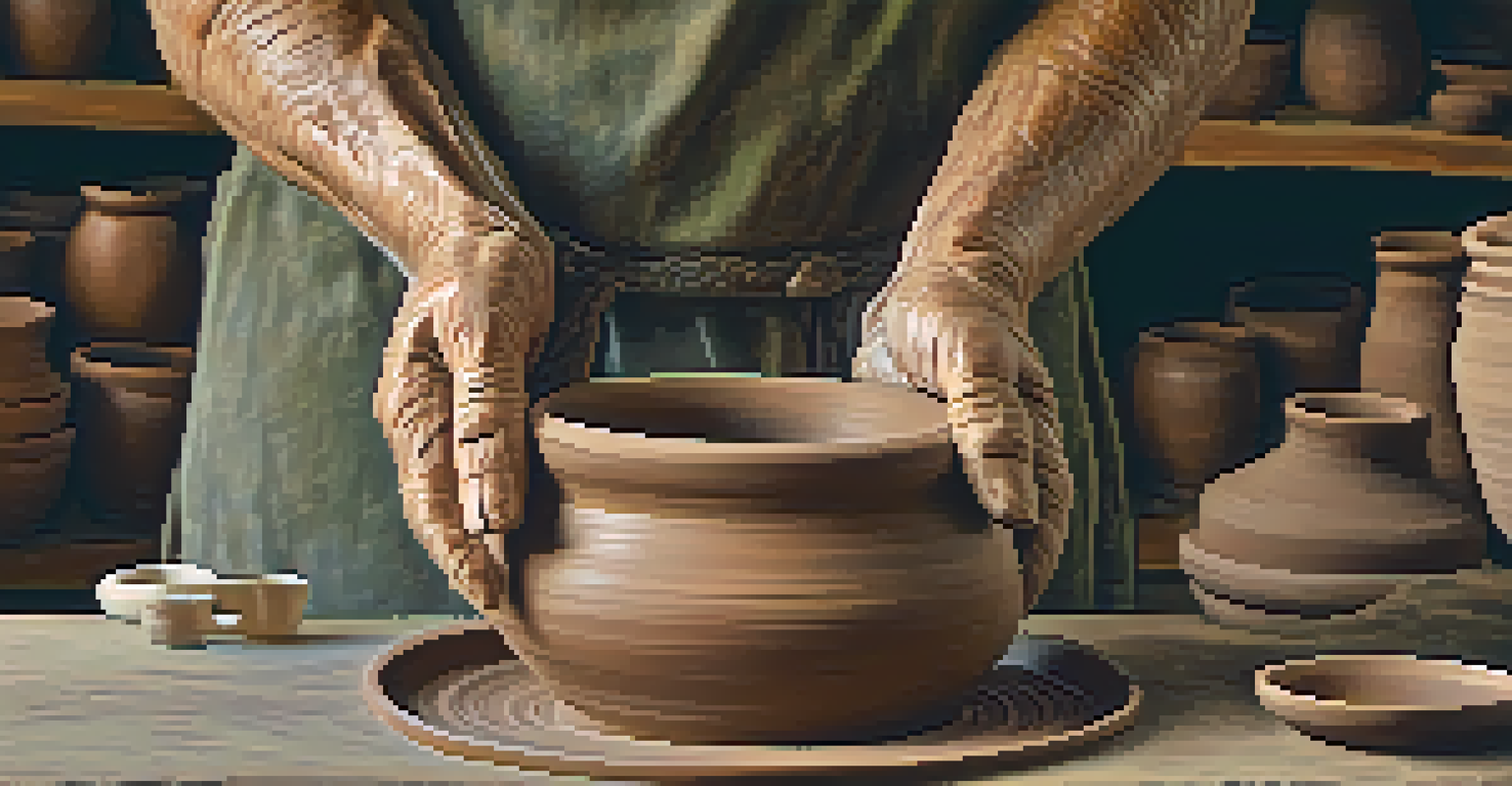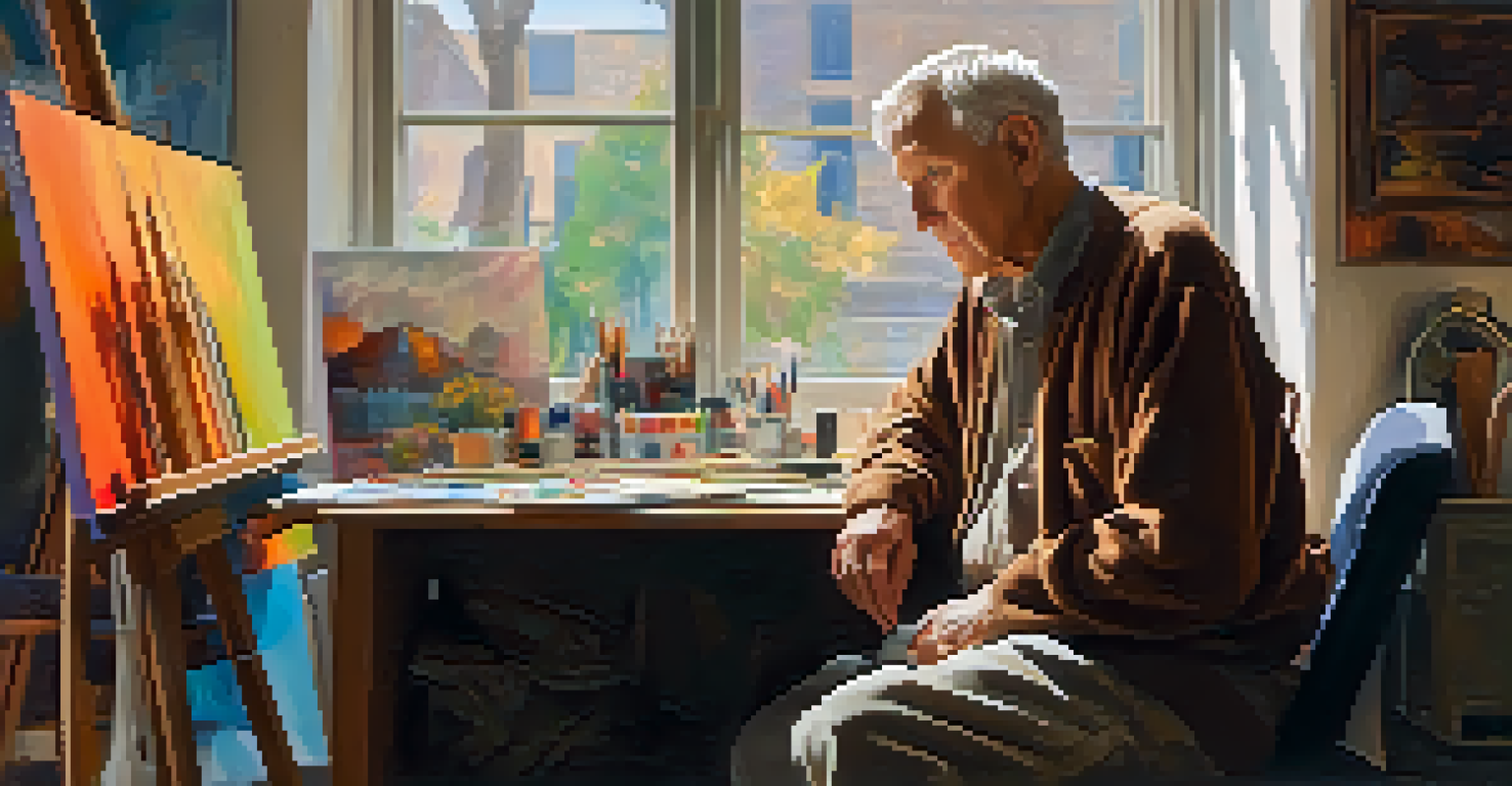Artistic Reflections on Aging: Time's Impact on Identity

Understanding Aging: An Artistic Perspective
Aging is often viewed through a clinical lens, but for artists, it can be a profound source of inspiration. As time passes, experiences accumulate, shaping not just our bodies but also our creative expressions. Artists reflect on their journey through aging, capturing the essence of life’s transitions in their work.
The artist's job is to be a witness to their own life and to the lives of others, to capture the essence of what it means to be human.
Consider the poignant works of artists like Vincent van Gogh, whose later pieces reveal the depth of his emotional and physical struggles. Each brushstroke tells a story of resilience, vulnerability, and the beauty found in imperfection. This connection between aging and artistry invites us to explore how identity evolves over time.
Ultimately, understanding aging from an artistic perspective allows us to appreciate the richness of life experiences. It challenges societal norms that often stigmatize aging, encouraging a more nuanced view that celebrates growth and transformation.
The Intersection of Time and Identity in Art
Time influences not only our physical selves but also our identities, which artists often explore in their work. As we age, the layers of our identity become more complex, merging past experiences with present realities. This intersection can be a fertile ground for creativity, as artists depict the multifaceted nature of their existence.

Take, for instance, the photography of Nan Goldin, who captures intimate moments that reflect her evolving identity over decades. Her images resonate with viewers, inviting them to confront their own perceptions of aging and identity. Such works highlight how time can serve as both a muse and a mirror, reflecting our inner selves.
Aging Inspires Artistic Expression
Artists often draw inspiration from their experiences with aging, capturing the beauty and complexity of life through their work.
By examining this intersection, we gain insight into how our identities shift with time, fostering a deeper understanding of our shared human experience. Artists invite us to engage with these themes, prompting reflection on our own journeys through life.
Aging as a Source of Creativity and Innovation
Contrary to the stereotype that creativity wanes with age, many artists find that their later years bring newfound inspiration. The wisdom and clarity gained through life experiences can lead to innovative artistic expressions. This period can become a time of exploration, allowing artists to push boundaries and redefine their work.
Aging is not lost youth but a new stage of opportunity and strength.
For example, Georgia O'Keeffe continued to innovate in her art well into her later years, embracing new techniques and themes. Her work reflects a profound understanding of nature and self, demonstrating that aging can enhance creativity rather than diminish it. This narrative reshapes our understanding of what it means to be an artist at any age.
Celebrating aging as a catalyst for creativity encourages us to view our own lives as a canvas. Each year adds depth to our personal stories, providing rich material for artistic expression.
Cultural Perspectives on Aging and Art
Cultural narratives around aging greatly influence how artists approach their work. In some societies, aging is revered, seen as a time of wisdom and respect, while in others, it may be stigmatized. These perspectives shape the themes and subjects artists choose to explore, reflecting broader societal values.
For instance, Japanese culture often honors the elderly, and this respect can be seen in the works of artists like Yayoi Kusama, whose installations celebrate the beauty of life at all ages. Her art reflects a deep connection to her experiences and the wisdom that comes with longevity. This cultural lens enriches our understanding of the aging process through art.
Cultural Views Shape Art on Aging
Different cultural narratives about aging influence how artists approach their subjects, reflecting broader societal values.
By examining these cultural differences, we can appreciate the diverse ways artists express the complexities of aging. These reflections challenge us to reconsider our own views and the narratives we uphold about aging.
Art as a Tool for Navigating the Aging Process
Art serves as a powerful tool for individuals navigating the challenges of aging. Creating or engaging with art can be therapeutic, helping to process emotions and experiences related to growing older. It offers a means of self-expression, allowing individuals to articulate their thoughts and feelings about aging.
For many, participating in art therapy has proven beneficial, providing a safe space to explore their identity and experiences. This practice emphasizes the power of creativity as a means of understanding and coping with life changes. As artists, sharing these experiences through their work can resonate deeply with audiences facing similar challenges.
Through art, we find connection and community, fostering discussions around aging that are often overlooked. This dialogue can empower individuals to embrace their journeys with confidence and creativity.
The Role of Memory in Artistic Reflections on Aging
Memory plays a crucial role in how artists depict aging, serving as both a source of inspiration and a subject of exploration. As we age, our memories shape our identities, influencing how we perceive ourselves and our artistic expressions. Artists often draw on personal or collective memories to create works that resonate with their audiences.
Consider the poignant storytelling in the works of artists like Frida Kahlo, whose paintings reflect her struggles and memories throughout her life. Her art is a testament to how memories can shape identity and creativity, offering a glimpse into the artist's inner world. This connection between memory and aging enriches our understanding of life’s complexities.
Memory Influences Artistic Identity
Memory plays a key role in how artists depict aging, shaping their identities and informing their creative expressions.
By embracing memory as a central theme, artists invite us to reflect on our own experiences and the impact they have on our identities. This exploration can lead to deeper insights about our lives and the passage of time.
Future Directions: Aging, Art, and Identity
Looking ahead, the relationship between aging, art, and identity continues to evolve. As society shifts its perspective on aging, artists will likely respond with innovative expressions that challenge traditional narratives. This evolution invites us to explore new themes and mediums that reflect the diverse experiences of aging.
Emerging artists are already reshaping the conversation, using digital platforms and mixed media to engage with audiences in fresh ways. Their work often highlights the interconnectedness of aging and technology, offering new possibilities for creative expression. This forward-thinking approach encourages dialogue and understanding around aging.

As we move into the future, the artistic reflections on aging will play a vital role in shaping our perceptions of identity. By embracing these changes, we can foster a culture that values creativity and wisdom at every stage of life.